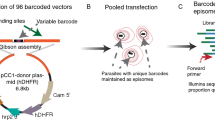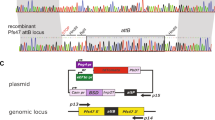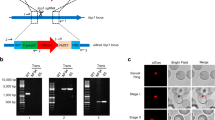Abstract
This protocol describes a methodology for the genetic transformation of the rodent malaria parasite Plasmodium berghei and the subsequent selection of transformed parasites expressing green fluorescent protein (GFP) by flow-sorting. It provides methods for: transfection of the schizont stage with DNA constructs that contain gfp as the selectable marker; selection of fluorescent mutants by flow-sorting; and injection of flow-sorted, GFP-expressing parasites into mice and the subsequent collection of transformed parasites. The use of two different promoters for the expression of GFP is described; these two promoters require slightly different procedures for the selection of mutants. The protocol enables the collection of transformed parasites within 10–12 days after transfection. The genetic modification of P. berghei is widely used to investigate gene function in Plasmodium sp. The application of flow-sorting to the selection of transformed parasites increases the possibilities of parasite mutagenesis, by effectively expanding the range of selectable markers.
This is a preview of subscription content, access via your institution
Access options
Subscribe to this journal
Receive 12 print issues and online access
$259.00 per year
only $21.58 per issue
Buy this article
- Purchase on Springer Link
- Instant access to full article PDF
Prices may be subject to local taxes which are calculated during checkout



Similar content being viewed by others
References
Koning-Ward, T.F., Janse, C.J. & Waters, A.P. The development of genetic tools for dissecting the biology of malaria parasites. Annu. Rev. Microbiol. 54, 157–185 (2000).
Carvalho, T.G. & Menard, R. Manipulating the Plasmodium genome. Curr. Issues Mol. Biol. 7, 39–55 (2005).
Cowman, A.F. & Crabb, B.S. Molecular Approaches to Malaria. (ed. Sherman, I.W.) 50–67 (ASM Press, Washington, D.C., 2005).
Janse, C.J. et al. High efficiency transfection of Plasmodium berghei facilitates novel selection procedures. Mol. Biochem. Parasitol. 145, 60–70 (2006).
Janse, C., Ramesar, J. & Waters, A.P. High efficiency transfection and drug-selection of genetically transformed blood stages of the rodent malaria parasite P. berghei. Nature Protocols 1, 346–256 (2006).
Waters, A.P. et al. Transfection of malaria parasites. Methods 13, 134–147 (1997).
Menard, R. & Janse, C. Gene targeting in malaria parasites. Methods 13, 148–157 (1997).
Franke-Fayard, B. et al. Murine malaria parasite sequestration: CD36 is the major receptor, but cerebral pathology is unlinked to sequestration. Proc. Natl. Acad. Sci. USA 102, 11468–11473 (2005).
Kocken, C.H. et al. Precise timing of expression of a Plasmodium falciparum-derived transgene in Plasmodium berghei is a critical determinant of subsequent subcellular localization. J. Biol. Chem. 273, 15119–15124 (1998).
Amino, R., Menard, R. & Frischknecht, F. In vivo imaging of malaria parasites — recent advances and future directions. Curr. Opin. Microbiol. 8, 407–414 (2005).
Heussler, V. & Doerig, C. In vivo imaging enters parasitology. Trends Parasitol. 22, 192–195 (2006).
Gilks, C.F. et al. Host diet in experimental rodent malaria: a variable which can compromise experimental design and interpretation. Parasitology 98, 175–177 (1989).
Acknowledgements
We would like to thank J. Ramesar, H. Kroeze and S. Khan for their critical comments, and M. van der Keur and R. van der Linden for their help with the development of the flow-sorting procedure.
Author information
Authors and Affiliations
Corresponding author
Ethics declarations
Competing interests
The authors declare no competing financial interests.
Rights and permissions
About this article
Cite this article
Janse, C., Franke-Fayard, B. & Waters, A. Selection by flow-sorting of genetically transformed, GFP-expressing blood stages of the rodent malaria parasite, Plasmodium berghei. Nat Protoc 1, 614–623 (2006). https://doi.org/10.1038/nprot.2006.88
Published:
Issue Date:
DOI: https://doi.org/10.1038/nprot.2006.88
This article is cited by
-
A versatile Plasmodium falciparum reporter line expressing NanoLuc enables highly sensitive multi-stage drug assays
Communications Biology (2023)
-
Streamlining sporozoite isolation from mosquitoes by leveraging the dynamics of migration to the salivary glands
Malaria Journal (2022)
-
A universal vaccine candidate against Plasmodium vivax malaria confers protective immunity against the three PvCSP alleles
Scientific Reports (2021)
-
Definition of constitutive and stage-enriched promoters in the rodent malaria parasite, Plasmodium yoelii
Malaria Journal (2020)
-
A cryptic cycle in haematopoietic niches promotes initiation of malaria transmission and evasion of chemotherapy
Nature Communications (2018)
Comments
By submitting a comment you agree to abide by our Terms and Community Guidelines. If you find something abusive or that does not comply with our terms or guidelines please flag it as inappropriate.



